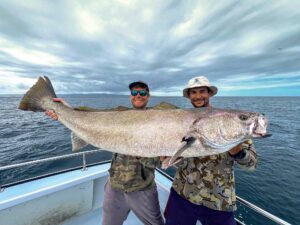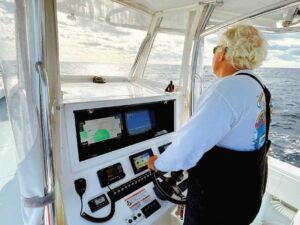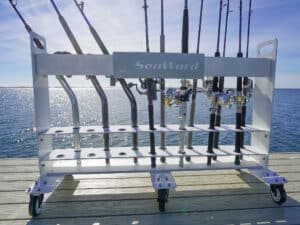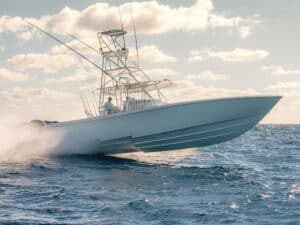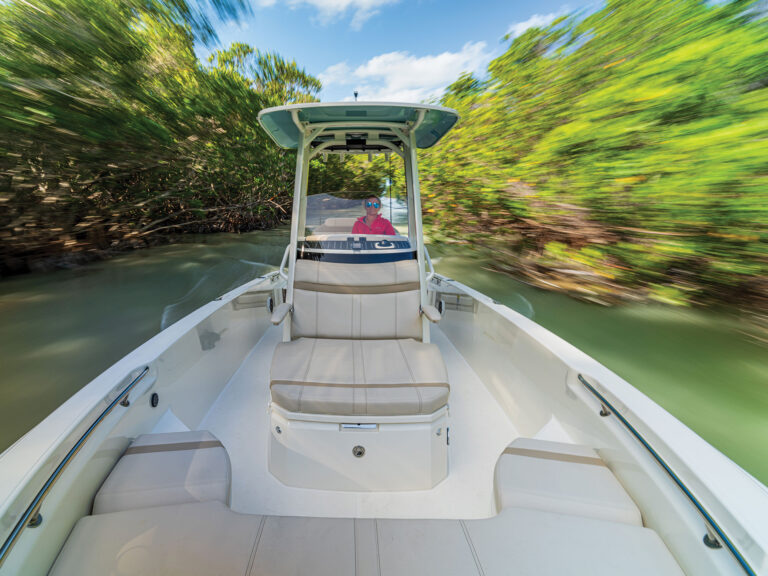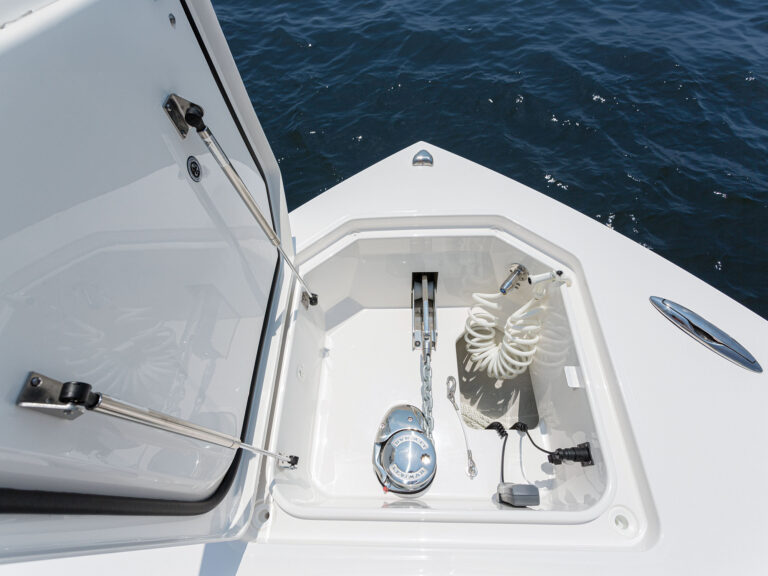
Craig Hardie and I watched Dan Quinn struggle with the big grouper he’d hooked on a swimming plug. With an intimidating collection of rocks and boulders 14 feet beneath us and a grouper hellbent on reaching them, we kept my Shallow-Water MARC slowly moving forward to help drag the fish over tamer habitat. It worked. After a strenuous several minutes, Quinn was all smiles over his prize: a husky gag that we promptly released (it was closed SEASON FOR GROUPER).
Talk about transparency! The above scenario could have played out offshore, where grouper thrive. But Quinn fought his fish in plain view of thousands inside office buildings and condos, close enough for them to identify the beverages we were drinking and the lures we were using. We were that close to downtown Miami, fishing Biscayne Bay.

No Fluke
That grouper was not an incidental catch. We set forth to target them, and we caught and released five more gags that day. Just a few months prior, my friend, Harry Vernon III, and I trolled them up in Biscayne Bay for one of my NBC Sports TV episodes, in addition to a 100-pound-class tarpon that inhaled our Rapala swimming plug.
Hardie, an accomplished Biscayne Bay angler and City of Hialeah firefighter, is one of a few who have been trolling up impressive gag grouper on these waters for a long time. Mention trolling for keeper-size gag grouper in the Bay to most Miami-Dade anglers and they’ll think you’ve been hitting the sauce. Yet, it’s a little-known fact that these fish exist and thrive here, passed up daily by countless anglers.

Inshore Digs
Gag grouper are indigenous to ledges, rock piles, wrecks and other hard structure set amid sandy and grassy bottom. They’re abundant along Florida’s southwest coast and the Gulf side of the Florida Keys, compared to the narrower, coral-like bottom of the Atlantic side of extreme South Florida. Here, they’re frequently caught around inlets and on shallower wrecks and hard bottom.
Gags also frequent estuaries for spawning and maturing. When they reach larger sizes, most migrate offshore. However, larger fish move in and out of these estuaries year-round, and some take up residence. Hardie has trolled them up in Biscayne Bay under the heat of summer as well as the cold of winter, when, traditionally, they become more abundant inshore.

Biscayne Bay holds the perfect gag grouper habitat. The freshwater influence from the Miami River and the Intracoastal Waterway (ICW) provides deeper habitat and prime ambush stations, where they gorge on crustaceans and baitfish swept off the bordering bottom. Major ocean thoroughfares the likes of Government, Norris and Bear Cut, Cape Florida Channel and the finger channels to the south provide not only transitional avenues for these fish, but also an abundance of forage. Factor in the constant seawater turnover, the bridges, scattered rocks and wrecks inside the Bay, and you’ve defined prime real estate for gags.
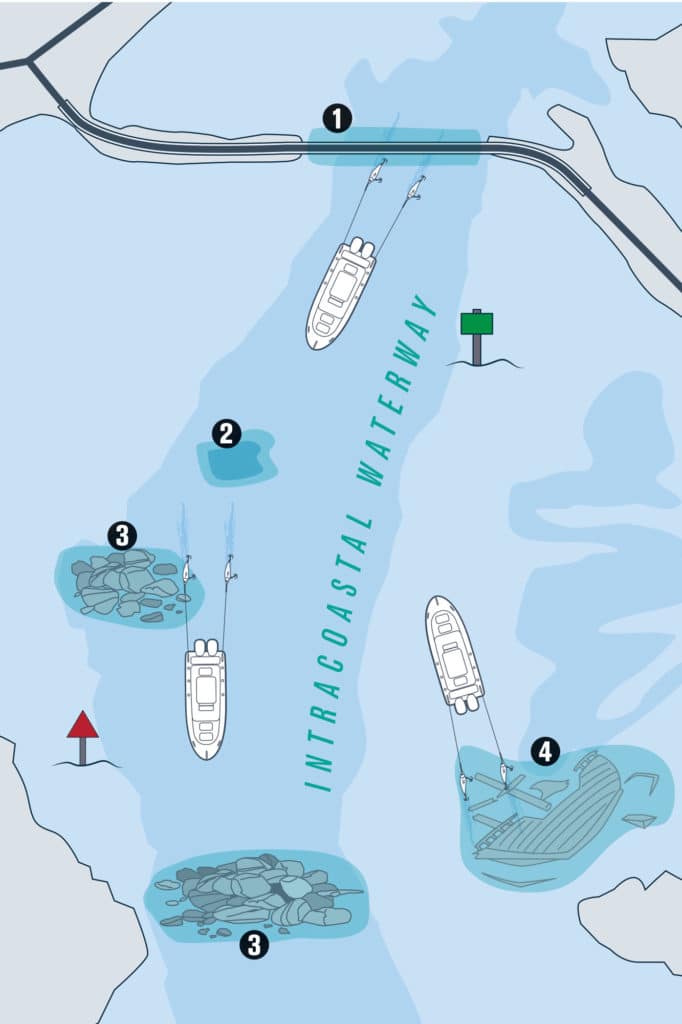
Dial It In
Hardie concedes that the ICW channel is one of the most consistent places to troll for gags, which was proven on our trip. However, we also made passes by a handful of rubble points and a couple of wrecks south of Key Biscayne, where he consistently catches them. Search out parts of the ICW walls that jut out a bit. Such spots provide relief against current and prime ambush spots. Also, seek out rock piles scattered about the floor of the ICW channel, as well as precipitous drops, some as much as 3 to 5 feet, all prime habitat and ambush points.
Bay bridges also hold gags. Your best bet at the longer spans is trolling the length of the bridge, keeping tight to the pilings and focusing on both up- and down-current sides. As for wrecks and debris fields, troll parallel with and tight to each side. If a wreck sits deep enough to avoid snagging your lure, troll over it. Trolling is preferred over anchoring because it finds grouper by covering a lot of ground. And, upon hooking up, the moving boat helps pull the fish away from structure, boosting the odds of getting the larger fish to the boat.

Mag Rules
Gag grouper go nuts when swimming plugs scurry by just a few feet above their domain, and the Rapala Floating Magnum 18 is as potent a lure as there is. Compared to the Rapala CD 18, the deep-diving version is more conducive for trolling deep inlets, while the shallow runner can be trolled over shallow wrecks and debris. It also works well in the ICW, where depths vary from 10 to 15 feet. Color does not seem an issue as long as the plug stays in the strike zone. To muscle gags out of structure, we used Penn Fathom 15 and Torque 25 and 30 lever-drag reels, spooled with 50-pound Sufix 832 braid. The reels are matched to Penn Bluewater Carnage rods rated for 65- to 100-pound lines. Hardie prefers 80-pound line, reasoning big fish can still rock up and break lighter braid.

Fune-Tuning and Red Flags
We trolled two rods between 5 and 8 mph, occasionally stopping for the plugs to bump bottom. The goal is to keep the plugs between 3 and 5 feet above bottom. To reduce the line’s angle of entry into the water and to gain depth with minimal scope, hold the rod with the tip pointed at the water. Floating grass can be a pain, sometimes overbearing enough to force a run to other parts of the Bay. Steer your line around clumps of grass; you’ll want to feel the plug “pumping” along, which indicates it’s free of grass or debris.
Watch the sonar for any sudden bottom rise or shallowing in the ICW channel. To avoid snags, wind up the plugs and swim them over these points. Once beyond, drop the lures back into position.

Gag grouper strike trolled lures viciously. The sudden jolt and instant bend in the rod nearly rips the outfit from your hands. For a split second, you think you’ve snagged bottom, but when that bottom runs off under heavy drag, you know what you’ve got.
Hardie suggests maintaining trolling speed when hooked up, then leaving the other rod in play. Doubleheaders are common when gag grouper congregate. More importantly, the moving boat helps pull the grouper from its lair and away from cutoffs during the fight. Only when a hooked fish comes to the surface toward the end of the fight should you slow the boat, and then only slightly.
However, be prepared to do some fancy maneuvering when trolling, as well as some nail-biting when fighting fish. The most heavily traversed waters in Biscayne Bay camouflage some of its finest gag grouper spots. That adds another element to an already exciting type of fishing, Miami style.

SWS Planner
What: Gag grouper
Where: South Florida (Miami to Palm Beach)
When: Year-round, best during the cooler months
Who: This is a DIY fishery, available to any angler aboard a boat with a fish finder. Even those with bay boats and skiffs partake, as the fishing takes place primarily in protected waters.



